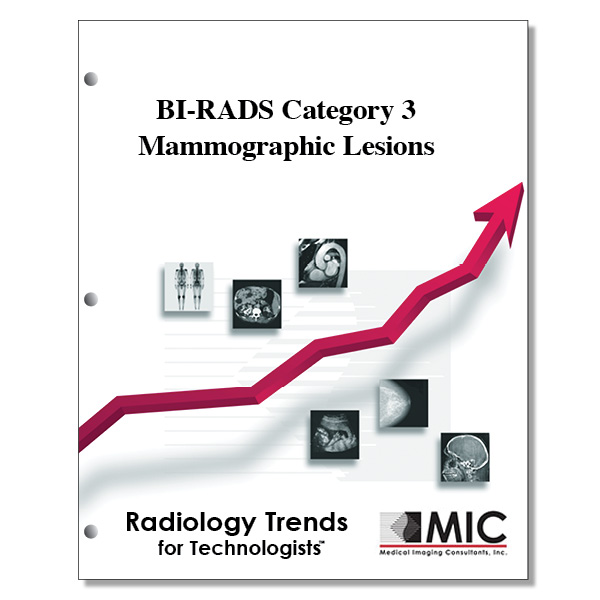

BI-RADS Category 3 Mammographic Lesions
A review of the proper usage of the BI-RADS category 3 classification and the follow-up imaging that should be performed.
Course ID: Q00539 Category: Radiology Trends for Technologists Modalities: Mammography, Sonography1.75 |
Satisfaction Guarantee |
$24.00
- Targeted CE
- Outline
- Objectives
Targeted CE per ARRT’s Discipline, Category, and Subcategory classification for enrollments starting after March 18, 2024:
[Note: Discipline-specific Targeted CE credits may be less than the total Category A credits approved for this course.]
Breast Sonography: 0.50
Patient Care: 0.50
Patient Interactions and Management: 0.50
Mammography: 1.50
Image Production: 0.25
Image Acquisition and Quality Assurance: 0.25
Procedures: 1.25
Anatomy, Physiology, and Pathology: 1.25
Registered Radiologist Assistant: 1.75
Safety: 0.75
Patient Safety, Radiation Protection, and Equipment Operation: 0.75
Procedures: 1.00
Thoracic Section: 1.00
Outline
- Introduction
- Change Weighed against Benign Morphology
- Masses
- Calcifications
- Focal Assymetries
- Challenging Clinical Scenarios
- One-View Findings
- Postoperative Breast
- Quality Control and Technical Parameters
- Errors in Management and Assessment
- Interobserver Variability
- Conclusion
Objectives
Upon completion of this course, students will:
- comprehend what BI-RADS category 3 means
- understand the goals of implementing the BI-RADS category 3 classification
- realize the likelihood of malignancy of a BI-RADS category 3 lesion
- recognize the type of breast imaging that should be completed before assigning the BI-RADS category 3 classification
- understand which mammographic findings are suitable for short-term follow-up
- realize under what alternate condition radiologists can assign a probably benign classification
- know the possible outcomes following a month waiting period after identifying an entity as fat necrosis
- recognize the appearance of hematomas at mammography and ultrasound
- know the BI-RADS fifth edition recommendation for follow-up waiting time to reassess a suspected breast hematoma
- understand the course of action if a benign-appearing solid mass demonstrates growth
- list benign calcifications that have classically benign features
- recognize what finding would prompt biopsy at follow-up imaging for calcifications
- define focal asymmetries
- understand the meaning of developing asymmetries
- realize the probability of malignancy when developing asymmetries are identified
- know another term that means one-view finding
- discuss the positive predictive value associated with one-view findings
- describe changes seen at mammography following an excision of a benign breast lesion
- identify changes seen at mammography following lumpectomy and radiation therapy
- differentiate architectural distortion from tumor recurrence
- learn about the technical differences from mammography exams that make it difficult to compare microcalcifications
- understand that motion blur found on mammography exams with microcalcifications often prompts incorrect BI-RADS category 3 classification
- know that in order to draw a conclusion about the stability of a lesion it must also be seen on a prior study
- state the sensitivity for the detection of cancer with screening mammography on the augmented and nonaugmented breast
- list common reasons for incomplete assessment that may result in improper use of the BI-RADS category 3 classification
- recognize the proper BI-RADS assessment when a suspicious mammographic finding is followed by a negative ultrasound
- recall study findings on the percent of BI-RADS category 3 lesions that actually met the morphologic criteria to be considered probably benign lesions
- realize that varying nomenclature can be the cause of interobserver variability
- understand what radiologists should do to reduce interobserver variability
- know that an initial assessment of probable benignity should not bias the subsequent radiologist’s assessment
